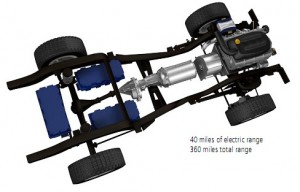Feb
10
Raser Tech’s Hybrid Drive Is Going On Road
February 10, 2009 | 6 Comments
Raser Technologies, Inc., a NYSE traded firm (RZ) announced it has released a video news report updating shareholders and the public on its progress to complete the full-sized SUV plug-in hybrid electric (PHEV) demonstration vehicle incorporating the Company’s Symetron technologies. Working in conjunction with FEV and a yet to be named global auto manufacturer, they have completed the integration of the 200 KW Symetron traction motor and 100 KW generator and initial testing of those components mounted in a vehicle and tested on a lift.
In the video news report, the Company discusses the vehicle on lift testing of the Symetron electricity controller components and also the delays in receiving and integrating lithium-ion batteries to complete the demonstration vehicle. The company announced that it expects to begin road tests of the completed vehicle in March.
Patrick Schwartz, President of Raser says, “I am very pleased with the progress that Jim Spellman and his team have made towards completing this project. We are looking forward to demonstrating the full capabilities of this vehicle, even with the current difficult times in the automotive market.” They just might have solutions for some of those difficulties with a fast introduction.
You may recall we have looked at Raser in previous posts about their incredible growth in geothermal power installations. Located in Provo Utah, enjoying local support and close proximately to low temperature geothermal heat, that business section is going great.
The video deals with another market Raser is racing to lead. They have a set of major components for vehicles starting with a generator that can connect to an engine, the electricity controller unit and the drive motor. Those are the major components to making a series hybrid drive. As you’ll see in the video the engine is directly connected to the generator, which is interfacing the controller and then the motor so eliminating the direct to wheel connection. With the engine connecting to the generator and the motor connected to the transmission the engine is downsized so that it is maximized for efficiency. Power boosts for acceleration hill climbing and other high demands can be drawn from battery or capacitor storage. It is a true series hybrid arrangement.
Curiously the motor and generator (alternating type) are conventional designs with several significant aspects of the electric motor’s geometric configuration and magnetic saturation implemented in completely different ways. Raser’s scientists have achieved some very significant innovations and produced working motors that prove the new theories. The results from performance tests have caught the attention of leading engineers. Notably is the high torque desired without permanent magnet materials, improved efficiency, lower cost per kilowatt and higher peak amps.
Permanent magnets pose some challenges when compared to induction motors (electromagnets). Permanent magnet motors rely on rare earth materials, the manufacturing requires an expensive magnet formation process, they do not lend themselves to large high output motors, the magnetic fields are constant which limits the modulation needed for smooth operation and they fail dramatically vs. needing disassembled and rewound. Induction field magnets for power systems are the smart way to go as they bring robust, durable and reliable aspects with a hundred years of experience behind them.
An example is of the performance that Raser has integrated into the old induction technology was done at Revolution Engineering of Detroit. Revolution used the Raser controller on a four-quadrant dynamometer test stand to provide the torque capacity necessary for the electric motor.
The test used a Raser model P2, about 8 x 12.5 inches, a common size for use in hybrid designs at 147 pounds. It’s also about the same size as the permanent magnet motor used by Toyota in the Prius. The test showed a torque output of (hold on) 420 ft pounds while running continuously, and air-cooled. The Toyota Prius is known to make 290 ft pounds and is liquid cooled. The power is calculated at 179 kilowatts at 3000 rpm yielding 240-horsepower. Remember that 8 x12.5 inch size?
Keep in mind that the optimized engine to power the generation set only needs to be 2 liters. A goal they are expressing is fleet units getting to 40 miles on batteries and local typical daily driving fuel efficiency of 100 mpg with a range on batteries up to 60 miles.
On the other hand is the near 980-pound weight added which is likely the batteries, as the engine weight reduction replaced by a gen set and motor would be much closer. Then there are the lithium battery price and availability issues. Something that EEStor might want to be attending to as these are going to be volume users.
Yet there is a tremendous appeal, forecast performance is 26 city and 38 highway. And this is at the market zone where big efficiency improvements make a huge difference in overall fuel use.
This is truly going to be interesting.
Comments
6 Comments so far



Hey very nice blog!!
I discovered your weblog web site on google and checked a few of your early posts. Proceed to maintain up the excellent operation. I just additional up your RSS feed to my MSN News Reader. Looking for ahead to studying extra from you later on!…
Hello, this is my first time i visit here. I found so many interesting in your blog especially on how to determine the topic. keep up the good work.
I REALLY liked your post and blog! It took me a minute bit to find your site…but I bookmarked it. Would you mind if I posted a link back to your post?
Good! Thank you! I always wanted to write in my site something like that. Can I take part of your post to my blog?
Interesting read, perhaps the best article iv’e browse today. We learn everyday cheers to you!